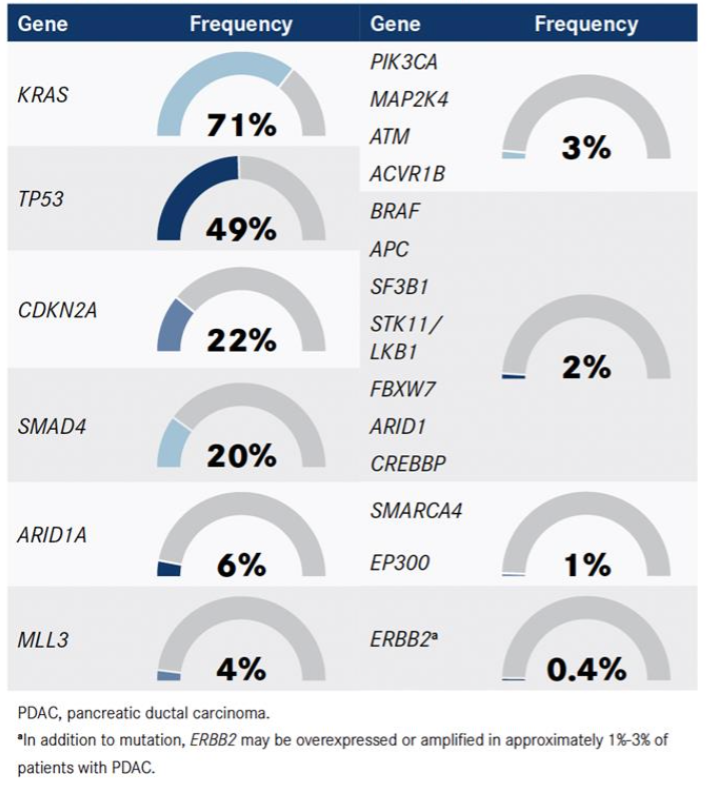Targeting Transcription as a New Frontier in Advanced Pancreatic Cancer
A new focus of research has reconsidered the mechanisms in regulating transcription as a novel target for advanced pancreatic ductal adenocarcinoma.
Jeremy Kratz, MD

Pancreatic ductal adenocarcinoma (PDAC) is a lethal cancer with a 5-year survival rate of 10%.1 For patients with advanced disease, there is a critical need to develop therapeutics with a long-term goal of improved clinical outcomes. The key molecular alterations in PDAC have been well described and include pathologic alterations in tumor suppressor genes CDKN2A, SMAD4, and TP53, as well as in the oncogene KRAS.2,3 Few systemic treatment options effectively target pathologic alterations in these genes (Figure).2
Figure. Common Mutated Genes of PDAC2

Tissue-agnostic approvals have led to the availability of new therapeutic agents in PDAC. These pathologic alterations include mismatch repair deficient with microsatellite instability,4,5 BRAF V600E,3 and rare gene fusions of NTRK6 and NRG1.7 Recent research has suggested that epigenetic changes across cancer types provide plasticity that facilitate adaptive resistance.8 It remains uncertain whether preclinical models of adaptive resistance mediated through transcription can be successfully targeted to improve clinical outcomes. As such, a new focus of research has reconsidered the mechanisms in regulating transcription as a novel target for advanced disease.
Targeting Transcriptional Regulation in PDAC
Transcription factors are key regulators of cancer proliferation and adaptation within the context of the tissue microenvironment and physiologic states of stress.10 Historic approaches to targeting transcription across cancer types have inhibited hormonal signaling,11 regulatory protein-protein interactions,12 and pathways of proteasomal degradation.13
Although these mechanisms are well described, the success of clinical targeting in PDAC has remain modest to date. For example, the use of histone deacetylase (HDAC) inhibitors in PDAC has yet to yield objective response or survival advantage.14,15 BET inhibitors have largely been studied in preclinical models of PDAC.16 An ongoing phase 1 National Cancer Institute–sponsored clinical trial (NCT05053971) is investigating the combination of HDAC and BET inhibitors with planned phase 2 expansion that will focus on patients with PDAC. It is important to note that a majority of prior work has considered the use of single-agent epigenetic targets; however, evaluating novel combinations and studying transcriptional targets as a function of adaptive resistance may provide a pathway for future therapeutic development.
CDK7 is an integral regulator of transcription across cancer types that functions at the site of the gene promoter to mediate the activation of RNA polymerase II.17 In preclinical models of PDAC, CDK7 inhibition has been shown to induce apoptosis, cell cycle arrest, and repress NFκB signaling.18 Importantly, these same preclinical models with CDK7 inhibition showed significant downregulation of the transcription of master regulator MYC.19 CDK7 serves as dual function in both transcriptional regulation and checkpoints of cell cycling.20 The unique sensitivity of CDK7 inhibition for cancer has dependency on super-enhancer function in transcriptional regulation.21
Most prior work with CDK7 inhibition was performed with small molecule THZ1.18 It is important to consider that THZ1 has multiple off-target effects including inhibition of CDK12 and CDK13.17 THZ1 has not been supported in active clinical trials.
SY-1365 was first developed for improved selectivity against CDK7 with preclinical activity seen across multiple cancer types.22 This approach was further refined with SY-5609 based on structure-based discovery to achieve sub-nM on-target activity.23 Follow-up evaluation has shown activity of SY-5609 in multiple preclinical cancer models of PDAC with improvement in control of KRAS-mutant PDAC xenografts when combined with gemcitabine chemotherapy.23,24
Early-phase clinical trials with CDK7 inhibition have evaluated the safety profile of 3 unique CDK7 inhibitors including ICEC0942, SY-1365, and SY-5609.22,25,26 The safety and tolerability of SY-5609 monotherapy as an orally bioavailable agent has been reported from phase 1 investigation.26 Toxicities reported at grade 3 or higher included thrombocytopenia (15%), nausea (9%), anemia (9%), fatigue (9%), and abdominal pain (9%) in the population of patients who had multiple lines of prior therapy.26 Importantly, in the subgroup of participants with PDAC, 5 of 13 patients (38%) achieved disease control for advanced pancreatic cancer with single-agent SY-5609. This was notable for participants with disease progression after receiving both gemcitabine and combination 5-fluorouracil (5-FU)–containing chemotherapy, for whom standard-of-care therapeutic options remain limited. An ongoing dose-expansion cohort is actively recruiting (NCT04247126) to better understand the tolerability and activity of SY-5609 in combination with gemcitabine-containing chemotherapy.27
Context of Available Therapy
The treatment of pancreatic cancer requires personalized strategies that extend beyond the currently available cytotoxic chemotherapy. The current standard of care for metastatic pancreatic cancer remains as FOLFIRINOX28 (folinic acid, 5-FU, irinotecan hydrochloride, oxaliplatin) and gemcitabine/nabpaclitaxel.29 Importantly, homologous recombination deficiency has been shown to predict improved clinical outcomes with the early incorporation of platinum-containing chemotherapy.30 Distinct expression profiles may represent cancers with vulnerabilities to transcriptional targeting. These analyses could integrate with the understanding of GATA6 expression in defining basal versus classical subtypes of PDAC.31 Understanding the plasticity of adaptive resistance remains a critical unmet need for patients with advanced PDAC, particularly when considering the near-universal resistance to standard chemotherapy.
Jeremy Kratz, MD, is an assistant professor in the Department of Medicine, Division of Hematology, Medical Oncology, and Palliative Care at the University of Wisconsin (UW) School of Medicine and Public Health, and a member of the UW Carbone Cancer Center in Madison.
References
- Mizrahi JD, Surana R, Valle JW, Shroff RT. Pancreatic cancer. Lancet. 2020;395(10242):2008-2020. doi:10.1016/S01406736(20)30974-0
- Jones S, Zhang X, Parsons DW, et al. Core signaling pathways in human pancreatic cancers revealed by global genomic analyses. Science. 2008;321(5897):1801-1806. doi:10.1126/science.1164368
- Heestand GM, Kurzrock R. Molecular landscape of pancreatic cancer: implications for current clinical trials. Oncotarget. 2015;6(7):4553-4561. doi:10.18632/oncotarget.2972
- Luchini C, Brosens LAA, Wood LD, et al. Comprehensive characterisation of pancreatic ductal adenocarcinoma with microsatellite instability: histology, molecular pathology and clinical implications. Gut. 2021;70(1):148-156. doi:10.1136/gutjnl-2020-320726
- Marabelle A, Le DT, Ascierto PA, et al. Efficacy of pembrolizumab in patients with noncolorectal high microsatellite instability/mismatch repair–deficient cancer: results from the phase II KEYNOTE-158 study. J Clin Oncol. 2020;38(1):1-10. doi:10.1200/JCO.19.02105
- Drilon A, Laetsch TW, Kummar S, et al. Efficacy of larotrectinib in TRK fusion-positive cancers in adults and children. N Engl J Med. 2018;378(8):731-739. doi:10.1056/NEJMoa1714448
- Heining C, Horak P, Uhrig S, et al. NRG1 Fusions in KRAS wildtype pancreatic cancer. Cancer Discov. 2018;8(9):1087-1095. doi:10.1158/2159-8290.CD-18-0036
- Ougolkov AV, Bilim VN, Billadeau DD. Regulation of pancreatic tumor cell proliferation and chemoresistance by the histone methyltransferase enhancer of zeste homologue 2. Clin Cancer Res. 2008;14(21):6790-6796. doi:10.1158/1078-0432.CCR-08-1013
- Vervoort SJ, Devlin JR, Kwiatkowski N, Teng M, Gray NS, Johnstone RW. Targeting transcription cycles in cancer. Nat Rev Cancer. 2022;22(1):5-24. doi:10.1038/s41568-021-00411-8
- Bushweller JH. Targeting transcription factors in cancer - from undruggable to reality. Nat Rev Cancer. 2019;19(11):611-624. doi:10.1038/s41568-019-0196-7
- Garcia-Martinez L, Zhang Y, Nakata Y, Chan HL, Morey L. Epigenetic mechanisms in breast cancer therapy and resistance. Nat Commun. 2021;12(1):1786. doi:10.1038/s41467-021-22024-3
- Arkin MR, Tang Y, Wells JA. Small-molecule inhibitors of protein-protein interactions: progressing toward the reality. Chem Biol. 2014;21(9):1102-1114. doi:10.1016/j.chembiol.2014.09.001
- Manasanch EE, Orlowski RZ. Proteasome inhibitors in cancer therapy. Nat Rev Clin Oncol. 2017;14(7):417-433. doi:10.1038/ nrclinonc.2016.206
- Damaskos C, Garmpis N, Karatzas T, et al. Histone deacetylase (HDAC) inhibitors: current evidence for therapeutic activities in pancreatic cancer. Anticancer Res. 2015;35(6):3129-3135.
- Richards DA, Boehm KA, Waterhouse DM, et al. Gemcitabine plus CI-994 offers no advantage over gemcitabine alone in the treatment of patients with advanced pancreatic cancer: results of a phase II randomized, double-blind, placebo-controlled, multicenter study. Ann Oncol. 2006;17(7):1096-1102. doi: 0.1093/annonc/mdl081
- Sahai V, Redig AJ, Collier KA, Eckerdt FD, Munshi HG. Targeting BET bromodomain proteins in solid tumors. Oncotarget. 2016;7(33):53997-54009. doi:10.18632/oncotarget.9804
- Sava GP, Fan H, Coombes RC, Buluwela L, Ali S. CDK7 inhibitors as anticancer drugs. Cancer Metastasis Rev. 2020;39(3):805-823. doi:10.1007/s10555-020-09885-8
- Lu P, Geng J, Zhang L, et al. THZ1 reveals CDK7-dependent transcriptional addictions in pancreatic cancer. Oncogene. 2019;38(20):39323945. doi:10.1038/s41388-019-0701-1
- Poole CJ, van Riggelen J. MYC—master regulator of the cancer epigenome and transcriptome. Genes (Basel). 2017;8(5):142. doi:10.3390/genes8050142
- Schachter MM, Fisher RP. The CDK-activating kinase Cdk7: taking yes for an answer. Cell Cycle. 2013;12(20):3239-3240. doi:10.4161/ cc.26355
- Bradner JE, Hnisz D, Young RA. Transcriptional addiction in cancer. Cell. 2017;168(4):629-643. doi:10.1016/j.cell.2016.12.013
- Hu S, Marineau JJ, Rajagopal N, et al. Discovery and characterization of SY-1365, a selective, covalent Inhibitor of CDK7. Cancer Res. 2019;79(13):3479-3491. doi:10.1158/0008-5472.CAN-19-0119
- Marineau JJ, Hamman KB, Hu S, et al. Discovery of SY-5609: a selective, noncovalent inhibitor of CDK7. J Med Chem. 2022;65(2):14581480. doi:10.1021/acs.jmedchem.1c01171
- Henry SH, Johannessen L, Sawant P, et al. SY-5609, a highly potent and selective oral CDK7 inhibitor, exhibits robust antitumor activity in preclinical models of KRAS mutant cancers as a single agent and in combination with chemotherapy. Ann Oncol. 2021;32(suppl 5):S364. doi:10.1016/j.annonc.2021.08.291
- Patel H, Periyasamy M, Sava GP, et al. ICEC0942, an orally bioavailable selective inhibitor of CDK7 for cancer treatment. Mol Cancer Ther. 2018;17(6):1156-1166. doi:10.1158/1535-7163.MCT-160847
- Sharma M, Bashir B, Hamilton E, et al. Tolerability and preliminary clinical activity of SY-5609, a highly potent and selective oral CDK7 inhibitor, in patients with advanced solid tumors. Ann Oncol. 2021;32(suppl 5):S587-S588. doi:10.1016/j.annonc.2021.08.1040
- Sharma M, Bashir B, Juric D, et al. Trial in progress: phase I study of SY-5609, a potent, selective CDK7 inhibitor, with initial expansion in adults with metastatic pancreatic cancer. J Clin Oncol. 2022;40(suppl 16):TPS4180. doi:10.1200/JCO.2022.40.16_suppl.TPS4180
- Conroy T, Desseigne F, Ychou M, et al; Groupe Tumeurs Digestives of Unicancer; PRODIGE Intergroup. FOLFIRINOX versus gemcitabine for metastatic pancreatic cancer. N Engl J Med. 2011;364(19):18171825. doi:10.1056/NEJMoa1011923
- Von Hoff DD, Ervin T, Arena FP, et al. Increased survival in pancreatic cancer with nab-paclitaxel plus gemcitabine. N Engl J Med. 2013;369(18):1691-1703. doi:10.1056/NEJMoa1304369
- Park W, Chen J, Chou JF, et al. Genomic methods identify homologous recombination deficiency in pancreas adenocarcinoma and optimize treatment selection. Clin Cancer Res. 2020;26(13):32393247. doi:10.1158/1078-0432.CCR-20-0418
- O’Kane GM, Grünwald BT, Jang GH, et al. GATA6 expression distinguishes classical and Basal-like subtypes in advanced pancreatic cancer. Clin Cancer Res. 2020;26(18):4901-4910. doi:10.1158/1078-0432.CCR-19-3724



